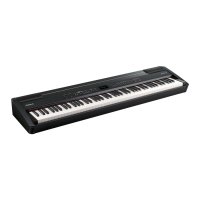43
Performing
Performing with the keyboard divided at a certain key into a left side and a right side is
called “Split Play,” and the point at which the keyboard is divided is called the “Split Point.”
In Split Play, you can have a different tone sound in the left and right sides.
When the instrument is turned on, the split point is set to “F 3.” The split point key is
included in the left side.
While in Split Play, a sound played in the right side is called an “Upper Tone,” and the
sound played in the left side is called a “Lower Tone.”
fig.SplitPoint-e.eps
As an example, here’s how to play the tone of the [Piano] button as part of a Split play.
fig.Panel-Split-4.eps
Performing with Different Tones in the Left and Right Sides of the
Keyboard (Split Play)
Spilit Point (Power-up default: F 3)
C1 D1 E1 F1 G1 A1 B1A0 B0 C2 C3 C4 C5 C8B7
Lower Tone Upper Tone
FP-7-e.book 43 ページ 2006年12月14日 木曜日 午前10時57分

